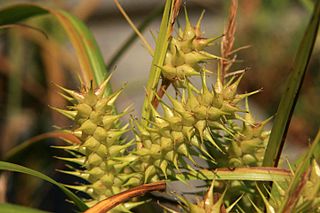
Carex flacca, with common names blue sedge, gray carex, glaucous sedge, or carnation-grass,, is a species of sedge native to parts of Europe and North Africa. It is frequent in a range of habitats, including grasslands, moorlands, exposed and disturbed soil, and the upper edges of salt marshes. It has naturalized in eastern North America.
Carex nudata is a species of true sedge known by several common names, including torrent sedge, California black-flowering sedge, Dudley's sedge, and naked sedge.

Carex lasiocarpa is a broadly distributed species of wetland sedge sometimes known as woollyfruit sedge or slender sedge. It is considered a species of Least Concern by the IUCN Red List due to its extensive range with many stable populations.

Carex athrostachya is a species of sedge known by the common name slenderbeak sedge. It is native to western North America, including Alaska to central Canada, the western contiguous United States, and just into Baja California.

Carex hoodii is a species of sedge known by the common name Hood's sedge. It is native to western North America from Alaska to Nunavut to California to South Dakota, where it grows in dry to moist habitat in forests and on mountain slopes.

Carex jonesii is a species of sedge known by the common name Jones' sedge.

Carex luzulina is a species of sedge known by the common name woodrush sedge.

Carex phaeocephala is a species of sedge known by the common name dunhead sedge.

Carex praegracilis is a species of North American sedge known as clustered field sedge, field sedge, and expressway sedge. Carex praegracilis is cultivated in the specialty horticulture trade as lawn substitute and meadow-like plantings.

Carex rossii, commonly known as Ross's sedge, is a hardy species of sedge that is often a pioneer species in areas with little or no established vegetation, or in places where disturbance has occurred. Ross's sedge grows in a variety of habitats throughout much of western North America, from Alaska to Ontario, south to New Mexico and California. It flowers in May and June.

Carex scoparia is a species of sedge known by the common names broom sedge and pointed broom sedge. It should not be confused with the unrelated grass species known as "broom sedge," Andropogon virginicus.

Carex specifica is a species of sedge known by the common name narrowfruit sedge.

Carex straminiformis is a species of sedge known by the common name Shasta sedge.

Carex riparia, the greater pond sedge, is a species of sedge found across Europe and Asia. It grows in a variety of wet habitats, and can be a dominant species in some swamps. It is Britain's largest Carex, growing up to 130 cm tall, with glaucous leaves up to 160 cm long. It hybridises with a number of other Carex species, including the closely related Carex acutiformis – the lesser pond sedge. A variegated cultivar is grown as an ornamental grass.

Carex sect. Ovales is a section of the genus Carex, containing around 85 species of sedge. It is the most diverse section of the genus in North America, containing 72 species:

Carex sylvatica is a species of sedge found in deciduous woodlands across Europe. It typically reaches 60 cm (24 in) tall, and has an inflorescence made up of 3–5 pendent female spikes and a single male spike. It is also used as a garden plant, and has been introduced to North America and New Zealand.

Carex lacustris, known as lake sedge, is a tufted grass-like perennial of the sedge family (Cyperaceae), native to southern Canada and the northern United States. C. lacustris us an herbaceous surface-piercing plant that grows in water up to 50 cm (1.6 ft) deep, and grows 50–150 cm (1.6–4.9 ft) tall. It grows well in marshes and swampy woods of the boreal forest, along river and lake shores, in ditches, marshes, swamps, and other wetland habitat. It grows on muck, sedge peat, wet sand or silt, in filtered or full sunlight.

Carex lupuliformis, common name false hop sedge, is a perennial sedge of sporadic distribution found in the floodplain forests and ephemeral woodland ponds of central and eastern North America. The species typically produces four to seven leaves with sheaths of distal leaves of 3 to 21 cm whose ligules are rounded to triangular. Carex lupuliformis blooms between early June and early October, typically with "two to six proximal female spikes, distal spikes usually crowded, ascending, densely flowered, usually cylindric, much longer than broad; one to two terminal male spikes." Fruiting occurs between late July through early October. Fruit is described as "perigynia ascending to spreading, inflated, strongly veined, sessile, lance-ovoid, shiny, glabrous; beak conical; achenes stipitate, broadly diamond-shaped, scarcely if at all longer than wide, concave faces, angles thickened, prominently knobbed with hard, nipplelike points."

















